Two domains of the erythropoietin receptor are sufficient for Jak2 binding/activation and function
- PMID: 16982687
- PMCID: PMC1636781
- DOI: 10.1128/MCB.01035-06
Two domains of the erythropoietin receptor are sufficient for Jak2 binding/activation and function
Abstract
Biochemical and genetic studies have shown that Jak2 is an essential component of EpoR signal transduction which is required for normal erythropoiesis. However, whether Jak2 is the sole direct mediator of EpoR signal transduction remains controversial. To address this issue, we have used an extensive and systematic mutational analysis across the EpoR cytoplasmic tail and transmembrane domain with the goal of determining whether mutants that negatively affected EpoR biological activity but retained Jak2 activation could be identified. Analysis of over 40 mutant receptors established that two large domains in the membrane-proximal region, which include the previously defined Box1 and Box2 domains as well as a highly conserved glycine among cytokine receptors, are required for Jak2 binding and activation and to sustain biological activity of the receptor. Importantly, none of the mutants that lost the ability to activate Jak2 retained the ability to bind Jak2, thus questioning the validity of models of receptor reorientation for Jak2 activation. Also, no correlation was made between cell surface expression of the receptor and its ability to bind Jak2, thus questioning the role of Jak2 in trafficking the receptor to the plasma membrane. Collectively, the results suggest that Jak2 is the sole direct signaling molecule downstream of EpoR required for biological activity.
Figures

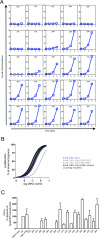
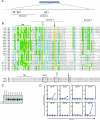

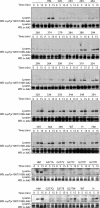

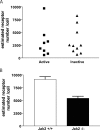
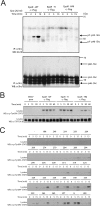

Similar articles
-
Jak2 FERM domain interaction with the erythropoietin receptor regulates Jak2 kinase activity.Mol Cell Biol. 2008 Mar;28(5):1792-801. doi: 10.1128/MCB.01447-07. Epub 2007 Dec 26. Mol Cell Biol. 2008. PMID: 18160720 Free PMC article.
-
A JAK2 interdomain linker relays Epo receptor engagement signals to kinase activation.J Biol Chem. 2009 Sep 25;284(39):26988-98. doi: 10.1074/jbc.M109.011387. Epub 2009 Jul 28. J Biol Chem. 2009. PMID: 19638629 Free PMC article.
-
STAT5 activation is critical for the transformation mediated by myeloproliferative disorder-associated JAK2 V617F mutant.J Biol Chem. 2010 Feb 19;285(8):5296-307. doi: 10.1074/jbc.M109.040733. Epub 2009 Dec 22. J Biol Chem. 2010. PMID: 20028972 Free PMC article.
-
[Analysis of the mechanism of polycythemia vera by studying JAK2 mutant-induced signaling pathway].Yakugaku Zasshi. 2011;131(8):1183-7. doi: 10.1248/yakushi.131.1183. Yakugaku Zasshi. 2011. PMID: 21804321 Review. Japanese.
-
Jak2 tyrosine kinase: a true jak of all trades?Cell Biochem Biophys. 2004;41(2):207-32. doi: 10.1385/cbb:41:2:207. Cell Biochem Biophys. 2004. PMID: 15475610 Review.
Cited by
-
EPO receptor circuits for primary erythroblast survival.Blood. 2008 Jun 1;111(11):5390-9. doi: 10.1182/blood-2007-10-119743. Epub 2008 Mar 18. Blood. 2008. PMID: 18349318 Free PMC article.
-
EPO receptor gain-of-function causes hereditary polycythemia, alters CD34 cell differentiation and increases circulating endothelial precursors.PLoS One. 2010 Aug 5;5(8):e12015. doi: 10.1371/journal.pone.0012015. PLoS One. 2010. Retraction in: PLoS One. 2020 Mar 4;15(3):e0230279. doi: 10.1371/journal.pone.0230279. PMID: 20700488 Free PMC article. Retracted.
-
Mechanistic insights into activation and SOCS3-mediated inhibition of myeloproliferative neoplasm-associated JAK2 mutants from biochemical and structural analyses.Biochem J. 2014 Mar 1;458(2):395-405. doi: 10.1042/BJ20131516. Biochem J. 2014. PMID: 24354892 Free PMC article.
-
The effect of erythropoietin on normal and neoplastic cells.Biologics. 2012;6:163-89. doi: 10.2147/BTT.S32281. Epub 2012 Jun 27. Biologics. 2012. PMID: 22848149 Free PMC article.
-
JAK2 activation by growth hormone and other cytokines.Biochem J. 2015 Feb 15;466(1):1-11. doi: 10.1042/BJ20141293. Biochem J. 2015. PMID: 25656053 Free PMC article. Review.
References
-
- Bonifacino, J. S. 2002. Quality control of receptor-kinase signaling complexes. Dev. Cell 2:1-2. - PubMed
-
- Constantinescu, S. N., L. J. Huang, H. Nam, and H. F. Lodish. 2001. The erythropoietin receptor cytosolic juxtamembrane domain contains an essential, precisely oriented, hydrophobic motif. Mol. Cell 7:377-385. - PubMed
-
- He, K., X. Wang, J. Jiang, R. Guan, K. E. Bernstein, P. P. Sayeski, and S. J. Frank. 2003. Janus kinase 2 determinants for growth hormone receptor association, surface assembly, and signaling. Mol. Endocrinol. 17:2211-2227. - PubMed
-
- Huang, L. J., S. N. Constantinescu, and H. F. Lodish. 2001. The N-terminal domain of Janus kinase 2 is required for Golgi processing and cell surface expression of erythropoietin receptor. Mol. Cell 8:1327-1338. - PubMed
Publication types
MeSH terms
Substances
Grants and funding
LinkOut - more resources
Full Text Sources
Miscellaneous
